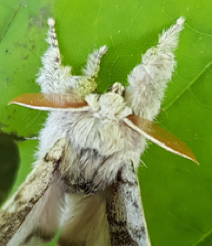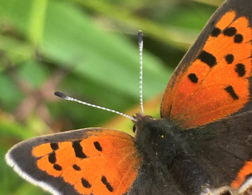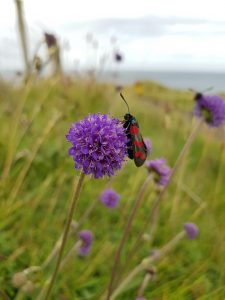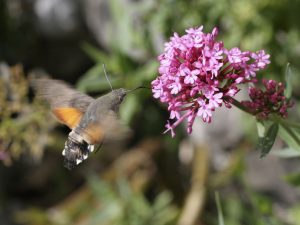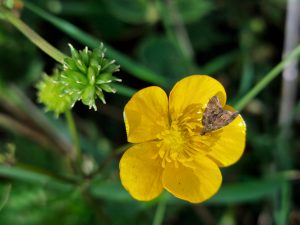Moths can be found anywhere, from the tops of mountains to the edges of sandy shores, on our farms and in our gardens. They play an important part in our landscape, interacting with many plants and animals. In Ireland, we have around 1,500 species of moth, compared to around 35 species of butterfly. Like butterflies, moths are ‘indicator species’, regular surveys of the volume and variety of moth species can tell us about the health of our natural environment and the effects of climate change.
Moth or Butterfly?
So, what’s the difference between a moth and a butterfly? Is it to do with what time of day they fly or perhaps their colouring? We can sometimes assume moths usually fly at night and are a duller colour and pattern compared to butterflies. But this is not the case, with some moths being exclusive day-fliers and many will dazzle you with their bright colours.
The line between butterfly and not-butterfly is a very blurred one. Both groups are from the family of Lepidoptera, which is very diverse and with a great number of species. Though it may be tricky, in Ireland there’s one helpful tip. Butterflies usually have ‘club shaped’ antennae (see image below, on the right, of a Small Copper Butterfly), while most moths have feathery or tapered ones (see image below, on the left, of a Pale Tussock Moth).
Moths can vary greatly in appearance, many species are very colourful, some use subtle patterns and shades as an aid for camouflage, while others can closely mimic insects such as wasps, bees and flies. Moths can be found all year round, even in the winter.
Moths as pollinators
Adult moths are important pollinators, recent research1 found that moths complement the work of daytime pollinators and help keep plant populations diverse and abundant, which in turn supports crop yields.
The research found that:
- Moth pollen transport networks are larger and more complex than networks for daytime pollinators.
- Moths visit flowers from a high number of plants also visited by bees, butterflies and hoverflies, but also interact with plants not commonly visited by these insects.
- Moths were carrying most pollen from the flowers they visited on their ‘furry’ bodies, this means of pollen transport from flower to flower by moths is similar to bees and hoverflies, many of which also collect pollen on their furry bodies.
Dr. Walton (University College London, Geography), lead author on the research, concluded: ‘While bumblebees and honeybees are known to be super pollinators, they also preferentially target the most prolific nectar and pollen sources. Moths may appear to be less effective pollinators by comparison, but their high diversity and abundance may make them critical to pollination in ways that we still need to understand. Our research sheds light on a little-known world of nocturnal plant-insect interactions that might be vital to the look and smell of our precious countryside and to the crops that we grow.’
A decline in numbers
Since the 1970s, moths have suffered steep declines in numbers. This has been due to changes in land use and the increasing use of pesticides. It is thought the decline in moth numbers may be affecting bird species such as Cuckoo, and Bat species that are reliant on moths as a food supply.
A Macro Moths Red List for Ireland was published by National Parks and Wildlife Service in 20162, and found 8% threatened and 4% Near Threatened or data deficient.
In the UK, studies have found the overall number of moths has decreased by 28% since 1968.
How can we help moths?
There are several ways we can help moths:
- Retain unimproved areas of farmland, such as along hedgerows, small woodlands, ditches/sheughs and ponds with marginal vegetation and areas of unimproved grassland,
- Create wildlife corridors, by linking unimproved areas/semi-natural habitat together with hedgerows and field margins,
- Use less pesticide,
- Encourage a wider diversity of plants in the landscape, including your garden,
- Raise the profile and understanding of the important role moths play in pollination and ecology.
Increasing our knowledge of moths
- MothsIreland and the National Biodiversity Data Centre partner to collect information on the distribution of moths in Ireland.
- MothsIreland is working to raise the profile and understanding of moths in Ireland. http://www.mothsireland.com
- You can also submit any Moth records to the National Biodiversity Data Centre https://records.biodiversityireland.ie/start-recording
- Click here to view moth distribution in Ireland https://maps.biodiversityireland.ie/Dataset/143
Here’s a few magical moths to inspire you!
Garden Tiger Moth
- Adults are nocturnal and fly between June and August
- Found in open areas including gardens, damp meadows, scrubby dunes, woods and hedgerows.
- Numbers appear to be declining in many areas.
Six-spot Burnet Moth
- Adults fly during the day from June to August
- Found in grassy coastal areas, meadows and woodland clearings.
- Adults attracted to thistles, knapweeds and scabious.
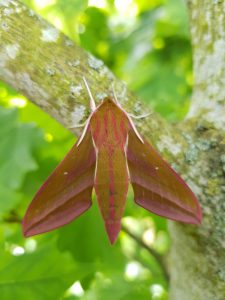 Elephant Hawk-moth © Ruth Wilson
Elephant Hawk-moth © Ruth Wilson
Elephant Hawk-moth
- Adult are nocturnal and fly between May and June
- They have wonderful pink and olive-green colouration
- Elephant hawk-moths can be seen resting during the day amongst the plants they feed on. Honeysuckle, Willowherb and other nectar-rich tubular flowers are preferred foodplants.
Hummingbird Hawk-moth
- Adults are day-flying and fly between June and September
- You may spot this amazing Mediterranean migrant as it hovers like a hummingbird amongst your flowers, it especially likes nectar-rich tubular flowers, like Red valerian and Honeysuckle.
- If you are lucky enough to see one, you can watch how it goes from flower to flower in a frantic way, looking for nectar, with its long proboscis uncoiled.
- A small micro moth, just 10 to 15mm wingspan
- It flies in the daytime from May to October
- It can sometimes be found in large numbers around clumps of nettles in hedgerows and gardens.
By Ruth Wilson, Farmland Officer, All-Ireland Pollinator Plan
References

